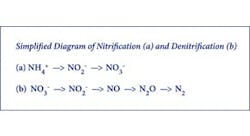Monitoring Wastewater Treatment Facility Efficiency and Effluent Quality
Ron Schuyler of RTW, Inc. approaches waste treatment from a holistic perspective, and regards wastewater treatment facilities (WWTFs) as complex living systems. The Bug Doctor, as Schuyler’s colleagues affectionately call him, understands the hydraulic, physicochemical and biological vital signs of these systems and can determine their condition. Should a malady be diagnosed, Schuyler prescribes the remedies necessary to return the system to optimum health.
Schuyler gets to the bottom of many WWTF problems by using a YSI 6820 sonde equipped with dissolved oxygen (DO), temperature, conductivity, pH, nitrate, ammonia and ORP, which is connected to a YSI handheld display. The sonde with handheld display is Schuyler’s window into the nature of the processes taking place within wastewater treatment systems and provides him with the data essential to make his diagnoses.
Close monitoring and control of biological, physicochemical and hydraulic conditions are necessary to optimize the environment within the WWTF so that the nitrification and denitrification processes can be harnessed and intensified consistently. Schuyler reports that, in addition to certain microbial community compositions and densities, there are a few vital signs (parameters) common to both processes that, if measured accurately and over time, can provide him with valuable insight regarding the overall performance of a WWTF. These parameters also allow him to diagnose the causes of reduced efficiency or diminishing effluent quality. This is where the YSI 6820 comes in handy.
Tantamount among the objectives of wastewater treatment is the removal of nitrogen, which, in combination with phosphorus, causes eutrophication of ambient waters. Nitrogen usually enters a wastewater treatment system in the form of ammonia (NH3) primarily and ammonium (NH4+). Influent ammonia, as well as ammonia in the early stages of treatment, is the result of hydrolysis of urea, while microbial decomposition of nitrogenous compounds (i.e., proteins) increases the ammonia later in the process. Other sources of influent ammonia include, but are not limited to, manufactured compounds such as chemical degreasers and other cleaning products.
In the treatment process, as in natural systems, ammonia not used for biosynthesis first undergoes nitrification, an aerobic process wherein ammonia is oxidized to nitrite, thence to nitrate. Nitrification is carried out by bacteria such as Nitrosomonas and Nitrobacter. Much of the energy released through this process is used to reduce CO2 for the formation of organic matter: a constant rejuvenation of the nitrifying community. At this stage, the treatment process may be reversed by harnessing another natural process, denitrification.
Denitrification is an anaerobic process wherein nitrate is reduced to nitrite, thence to elemental nitrogen, which is liberated to the atmosphere. It is important to note that, although some denitrification can occur aerobically, it occurs intensely under anaerobic conditions. Therefore, by maintaining anaerobic conditions (often termed “anoxic” if nitrate is available) at this phase of treatment, the WWTF can remove the maximum amount of nitrogen from the waste stream. Key participants in this process include many facultative anaerobic bacteria such as those in the genera Pseudomonas, Achromobacter and Escherichia. By harnessing and intensifying these natural processes, the WWTF can significantly decrease nitrogen concentrations from the waste stream before treated effluent is discharged to ambient waters.
Monitoring is the key to success
With the help of the YSI 6820 sonde and handheld display system, Schuyler and his colleagues continuously monitor DO, temperature, pH, ORP, ammonia and nitrate at various points within WWTFs for 12 to 24 hours.
Schuyler reports, “Temperature can vary somewhat; however, as long as levels do not change sharply or range widely from average or normal levels for these processes, few problems are observed. In contrast, pH, DO, ORP, ammonia and nitrate have, depending on the process, certain levels (or ranges) within which conditions are optimum; and outside of which treatment performance and efficiency, therefore effluent quality, will be diminished.”
Of these parameters, Schuyler depends most on ORP, ammonia and nitrate. “With these parameters, measured over time, I can determine if the process is sufficiently oxidizing or reducing, and where process (nitrification or denitrification) performance is relative to where it should be.”
With data from the sonde and handheld display, along with careful analysis of hydraulics and microbial community composition and density, Schuyler and company can diagnose causes of diminishing effluent quality, prescribe management strategies and corrective measures that will maintain and restore effluent quality, as well as improve efficiency and often reduce electrical costs.
Schuyler estimates that “…75% of the WWTFs not monitoring ORP, ammonia and nitrate, continuously or at least frequently, as part of their management program, could save significant operating costs and improve effluent quality if they did so.”
